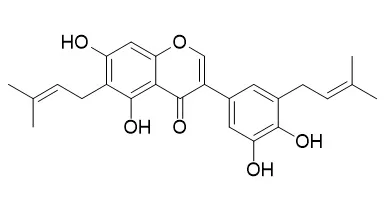| Kinase Assay: |
| Cancer Prev Res (Phila). 2013 Dec;6(12):1293-303. | | Isoangustone A, a novel licorice compound, inhibits cell proliferation by targeting PI3K, MKK4, and MKK7 in human melanoma.[Pubmed: 24104352 ] | Licorice root is known to possess various bioactivities, including anti-inflammatory and anticancer effects. Glycyrrhizin, a triterpene compound, is the most abundant constituent of dried licorice root. However, high intake or long-term consumption of glycyrrhizin causes several side effects, such as hypertension, hypertensive encephalopathy, and hypokalemia. Therefore, finding additional active compounds other than glycyrrhizin in licorice that exhibit anticancer effects is worthwhile.
METHODS AND RESULTS:
We found that Isoangustone A (IAA), a novel flavonoid from licorice root, suppressed proliferation of human melanoma cells. IAA significantly blocked cell-cycle progression at the G1-phase and inhibited the expression of G1-phase regulatory proteins, including cyclins D1 and E in the SK-MEL-28 human melanoma cell line. IAA suppressed the phosphorylation of Akt, GSK-3β, and JNK1/2. IAA also bound to phosphoinositide 3-kinase (PI3K), MKK4, and MKK7, strongly inhibiting their kinase activities in an ATP-competitive manner. Moreover, in a xenograft mouse model, IAA significantly decreased tumor growth, volume, and weight of SK-MEL-28 xenografts.
CONCLUSIONS:
Collectively, these results suggest that PI3K, MKK4, and MKK7 are the primary molecular targets of IAA in the suppression of cell proliferation. This insight into the biologic actions of IAA provides a molecular basis for the potential development of a new chemotherapeutic agent. |
|
| Cell Research: |
| Exp Biol Med (Maywood). 2011 Apr 1;236(4):435-44. | | Isoangustone A suppresses mesangial fibrosis and inflammation in human renal mesangial cells.[Pubmed: 21367880 ] | Development of diabetic nephropathy with fibrosis is associated with hypereglycemia-linked inflammation. Increased levels of proinflammatory factors have been found in diabetic patients with nephropathy.
METHODS AND RESULTS:
The present study was to test the hypothesis that Isoangustone A, a novel compound present in licorice, can inhibit renal fibrosis and inflammation inflamed by high glucose (HG) in human mesangial cells through disturbing transforming growth factor β (TGF-β) and nuclear facor κB (NF-κB) pathways. Serum-starved mesangial cells were cultured in 33 mmol/L glucose media. Cells were treated with 1-20 μmol/L Isoangustone A isolated from Glycyrrhiza uralensis licorice for three days. Exposure of cells to HG elevated connective tissue growth factor and collagen production, which was dose-dependently reversed by Isoangustone A. Isoangustone A boosted HG-plummeted membrane type matrix metalloproteinase (MMP)-1 expression and diminished HG-elevated tissue inhibitor of MMP-2 expression. HG activated mesangial TGF-β1-SMAD-responsive signaling, which was repealed by ≥10 μmol/L Isoangustone A. Furthermore, HG upregulated intracellular cell adhesion molecule-1 (ICAM-1) level and monocyte chemoattractant protein-1 (MCP-1) mRNA expression, and such increases were dose-dependently suppressed by Isoangustone A most likely through hampering TGF-β signaling pathways. Blockade of NF-κB signaling appeared to be responsible for attenuating HG-triggered induction of ICAM-1 and MCP-1.
CONCLUSIONS:
Our findings provide the first evidence that Isoangustone A dampens mesangial sclerosis associated with inflammation in response to HG through hindering TGF-β and NF-κB signaling. |
|






 Cell. 2018 Jan 11;172(1-2):249-261.e12. doi: 10.1016/j.cell.2017.12.019.IF=36.216(2019)
Cell. 2018 Jan 11;172(1-2):249-261.e12. doi: 10.1016/j.cell.2017.12.019.IF=36.216(2019) Cell Metab. 2020 Mar 3;31(3):534-548.e5. doi: 10.1016/j.cmet.2020.01.002.IF=22.415(2019)
Cell Metab. 2020 Mar 3;31(3):534-548.e5. doi: 10.1016/j.cmet.2020.01.002.IF=22.415(2019) Mol Cell. 2017 Nov 16;68(4):673-685.e6. doi: 10.1016/j.molcel.2017.10.022.IF=14.548(2019)
Mol Cell. 2017 Nov 16;68(4):673-685.e6. doi: 10.1016/j.molcel.2017.10.022.IF=14.548(2019)